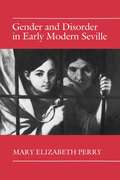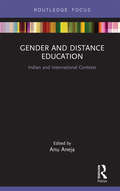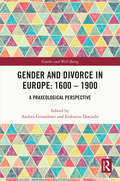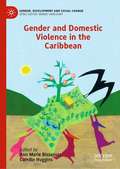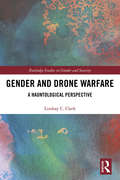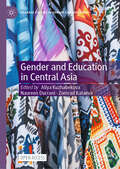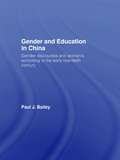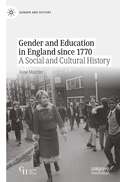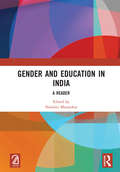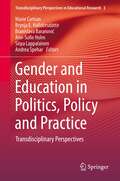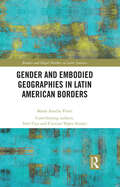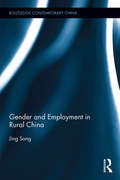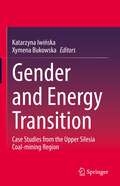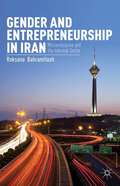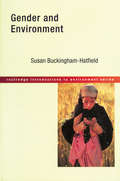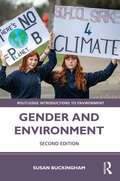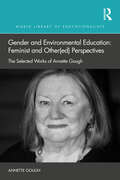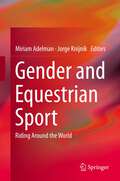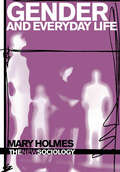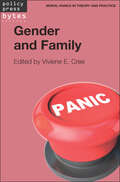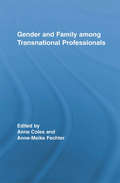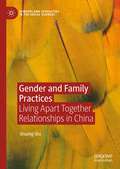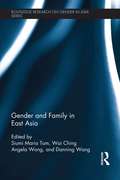- Table View
- List View
Gender and Disorder in Early Modern Seville
by Mary Elizabeth PerrySet in Seville, Spain during the Counter-Reformation era, this book is about the place of women in society and how the church and the government tried to curtail the women's growth.
Gender and Distance Education: Indian and International Contexts
by Anu AnejaThis book investigates the intersection of gender and distance education from a feminist perspective and explores their contemporary innovative interfaces in Indian and international contexts. The key issues raised here include a re- investigation of the democratizing potential of distance education from a gendered perspective (especially in developing countries such as India), feminist pedagogical perspectives on the notion of transactional distance, the relationship between masculinity and gerontology from the perspective of non- traditional modes, and the interrelationships between gender and social media from a distance education perspective. As opposed to the conventional, physical classroom, the virtual classroom often occupies a de- privileged space in feminist pedagogical discussions, since it appears to align itself less easily with feminist praxes which encourage a free, intellectual exchange between teachers and students. By opening up various facets of the relationship between gender, distance education and feminist pedagogy, the book foregrounds the critical need to re- visit preconceived, unfavourable assumptions about this relationship and proposes mutually productive inter-linkages. It does so in the context of contemporary circumstances defined by the increasing use of virtual technology, the ongoing need for democratization of higher education and the constraints posed by consumerist trends. Lucid and topical, this Focus volume will be useful to scholars and researchers of higher education, open and distance education, feminist pedagogy, gender studies, feminism, masculinity, and women’s studies as well as practitioners and policymakers working in the education sector.
Gender and Divorce in Europe: A Praxeological Perspective (Gender and Well-Being)
by Evdoxios Doxiadis Andrea GriesebnerGetting divorced and remarried are now common practices in European societies, even if the rules differ from one country to the next. Civil marriage law still echoes religious marriage law, which for centuries determined which persons could enter into marriage with each other and how validly contracted marriages could be ended. Religions and denominations also had different regulations regarding whether a divorce only ended marital obligations or also permitted remarriage during the lifetime of the divorced spouse. This book deals with predominantly handwritten documents of divorce proceedings from the British Isles to Western, Central and Southeastern Europe, and from 1600 to the 1930s. The praxeological analysis reveals the arguments and strategies put forward to obtain or prevent divorce, as well as the social and, above all, economic conditions and arrangements connected with divorce. The contributions break new ground by combining previously often separate fields of research and regions of investigation. It makes clear that the gender order doesn’t always run along religious lines, as was too often assumed. This book will be of interest to all scholars and students of economic, social, religious, cultural, legal and gender history as well as gender and well-being in a broader sense.
Gender and Domestic Violence in the Caribbean (Gender, Development and Social Change)
by Ann Marie Bissessar Camille HugginsDomestic violence, interpersonal violence, intimate partner violence, or gender-based violence continues to be a social problem that is rarely understood or discussed in many parts of society, worldwide. The same holds true in the Anglophone Caribbean. Most Caribbean societies are patriarchal in nature, as most men govern and create the political and economic landscape where citizens live. This edited volume brings together reputable scholars of rigorous academic research from various disciplines (e.g., political science, law, linguistics, criminology, nursing, social work and psychology) to clearly explain the conceptual definition of domestic violence within the Latin American and Caribbean region’s socio-political context. It will highlight who are the perpetrators as well as the victims of domestic violence and the consequences of allowing domestic violence to perpetuate in the region. This book is unique in the market today, as it is the only book grounded in the Caribbean providing a comprehensive overview of domestic violence with regards to the significance, victims, perpetrators, and the consequences.
Gender and Drone Warfare: A Hauntological Perspective (Routledge Studies in Gender and Security)
by Lindsay C. ClarkThis book investigates how drone warfare is deeply gendered and how this can be explored through the methodological framework of ‘Haunting’. Utilising original interview data from British Reaper drone crews, the book analyses the way killing by drones complicates traditional understandings of masculinity and femininity in warfare. As their role does not include physical risk, drone crews have been critiqued for failing to meet the masculine requirements necessary to be considered ‘warriors’ and have been derided for feminising war. However, this book argues that drone warfare, and the experiences of the crews, exceeds the traditional masculine/feminine binary and suggests a new approach to explore this issue. The framework of Haunting presented here draws on the insights of Jacques Derrida, Avery Gordon, and others to highlight four key themes – complex personhood, in/(hyper)visibility, disturbed temporality and power – as frames through which the intersection of gender and drone warfare can be examined. This book argues that Haunting provides a framework for both revealing and destabilising gendered binaries of use for feminist security studies and International Relations scholars, as well as shedding light on British drone warfare. This book will be of interest to students of gender studies, sociology, war studies, and critical security studies.
Gender and Education in Central Asia (Palgrave Studies in Gender and Education)
by Naureen Durrani Aliya Kuzhabekova Zumrad KataevaThis open access book brings together established and emerging scholars to explore policies, statistical trends and representative research on gender equity across post-Soviet Central Asia. The book provides an overview of policy development in the promotion of gender equity, a comparative summary of changes in gender equity indicators at various levels of education, and examples of current research on an array of issues relating to gender equity across the region. The chapters present a broad picture which will be relevant to scholars of educational reform, comparative education policy, international development and gender issues.
Gender and Education in China: Gender Discourses and Women's Schooling in the Early Twentieth Century (Routledge Contemporary China Series #Vol. 15)
by Paul J. BaileyGender and Education in China analyzes the significance, impact and nature of women's public education in China from its beginnings at the turn of the twentieth century. Educational change was an integral aspect of the early twentieth century state-building and modernizing reforms implemented by the Qing dynasty as a means of strengthening the foundations of dynastic rule and reinvigorating China's economy and society to ward off the threat of foreign imperialism. A significant feature of educational change during this period was the emergence of official and non-official schools for girls. Using primary evidence such as official documents, newspapers and journals, Paul Bailey analyzes the different rationales for women's education provided by officials, educators and reformers, and charts the course and practice of women's education describing how young women responded to the educational opportunities made available to them. Demonstrating how the representation of women and assumptions concerning their role in the household, society and polity underpinned subsequent gender discourses throughout the rest of the century, Gender and Education in China will appeal to students and scholars of Chinese history, gender studies, women's studies as well as an interest in the history of education.
Gender and Education in England since 1770: A Social and Cultural History (Gender and History)
by Jane MartinThis book takes a novel approach to the topic, combining biographical approaches and local history, a synthesis of sociological and historical literature, with new research to address a variety of themes and provide a comprehensive, rounded history demonstrating the entanglement of educational experience and the influence of different modes of discrimination and prejudice. Using the lens of gender, Jane Martin reassesses the gendered nature of the modern history of education and provides an overview of intertwined aspects of education, society, politics and power. Its organisation is user friendly, providing accessible information with regard to chronologies of legislation and key events to reflect constancy and change, whilst ‘mapping’ the larger political, economic, social and cultural contexts, making it ideal for use as a textbook or a resource for teachers and students.
Gender and Education in India: A Reader
by Simran LuthraExamining the complex linkages between gender and education in the Indian context forms part of a wider matrix of inquiry related to understanding gender and its intersections with class, caste, religion and region. The sixteen essays in this Reader by eminent scholars offer critical feminist perspectives covering many issues related to these linkages, examining ideologies, structural contexts, knowledge, pedagogy and experiences through a socio-historcal lens. They point to the range of sources and methods that can be used to uncover the linkages between gender and education such as quantitative data, literature, autobiographies, oral histories and ethnography. This book is co-published with Aakar Books, New Delhi. Taylor & Francis does not sell or distribute the print versions of this book in India, Pakistan, Nepal, Bhutan, Bangladesh and Sri Lanka.
Gender and Education in Politics, Policy and Practice: Transdisciplinary Perspectives (Transdisciplinary Perspectives in Educational Research #3)
by Andrea Spehar Marie Carlson Brynja E. Halldórsdóttir Branislava Baranović Ann-Sofie Holm Sirpa LappalainenThis book presents ideas on education, gender and intersectionality through a transdisciplinary frame by crossing disciplinary and methodological borders. Exploring the diversity of educational settings ranging from early childhood to adult education, it brings together scholars from various disciplines to discuss, deconstruct and problematize gender and education in relation to several themes in a comparative, intersectional, local, national, regional and international perspective. Each chapter approaches the topic in an intersectional and/or transnational manner and creates powerful gendered educational knowledge. Questions addressed in the book include: What are the challenges or barriers to gender-equal education? How can we understand the gaps between formal policies and educational practices? The chapters in the book illustrate how gender and education are relevant and needed concepts within the field of transdisciplinary research. The authors hail from a range of countries, such as Croatia, Indonesia, Turkey, UK, as well as the Nordic region, and they critically examine gender and education at all levels and in diverse sectors, and with varied lenses, such as neoliberalism in education, and the inclusion of newcomers and refugees. The work also critically investigates programs and pedagogical approaches, culture and values, knowledge and identity in teacher education. The book further addresses criticisms of Western and Anglophone bias around “white feminism” and the norm of white, male and heterosexual privilege.
Gender and Elections
by Richard L. Fox Susan J. CarrollThe new edition of this book describes the role of gender in the American electoral process through the 2008 elections. It strikes a balance between highlighting the most important developments for women as voters and candidates in the 2008 elections and providing a deeper analysis of the ways that gender has helped shape electoral politics in the United States. Individual chapters demonstrate the importance of gender in understanding presidential elections, voter participation and turnout, voting choices, the participation of African American women, congressional elections, the support of political parties and women's organizations, candidate communications with voters, and state elections. This updated volume also includes new chapters that analyze the roles of Latinas in U. S. politics and chronicle the candidacies of Hillary Clinton and Sarah Palin.
Gender and Elections
by Richard L. Fox Susan J. CarrollThe third edition of Gender and Elections offers a systematic, lively, and multifaceted account of the role of gender in the electoral process through the 2012 elections. This timely yet enduring volume strikes a balance between highlighting the most important developments for women as voters and candidates in the 2012 elections and providing a more long-term, in-depth analysis of the ways that gender has helped shape the contours and outcomes of electoral politics in the United States. Individual chapters demonstrate the importance of gender in understanding and interpreting presidential elections, presidential and vice-presidential candidacies, voter participation and turnout, voting choices, congressional elections, the political involvement of Latinas, the participation of African American women, the support of political parties and women's organizations, candidate communications with voters, and state elections. Without question, Gender and Elections is the most comprehensive, reliable, and trustworthy resource on the role of gender in US electoral politics.
Gender and Embodied Geographies in Latin American Borders (Borders and Illegal Markets in Latin America)
by Maria Amelia Viteri Iréri Ceja Cristina Yépez ArroyoGender and Embodied Geographies in Latin American Borders is the first study of its kind to bring a gender perspective to studies on violence and "illegal markets" in the region. Analyzing the structural problems that create inequality and enable gendered violence in Mexico, Guatemala, Colombia, Ecuador, Peru, Bolivia, Brazil and Argentina, the authors offer a critique of the securitization of borders and the criminalization of human mobility, and propose alternatives to reduce violence. Newspaper reports on gender and the variables of violence, human trafficking, people smuggling, missing persons, victims and perpetrators uncover the production and reproduction of discourses and images related to violence. Interviews with strategic actors from nongovernmental organizations, academia, as well as public policy makers diversify the experiences from the different voices of authority. Gender and Embodied Geographies in Latin American Borders encourages us to continue to question silence, impunity, the restriction of mobility, the dehumanization of securitization policies and the institutionalization of gender violence. A welcomed must read for scholars, researchers, policy makers, and students of gender studies, security studies and migration.
Gender and Employment in Rural China (Routledge Contemporary China Series)
by Jing SongWith China’s rapid advancements in urbanization and industrialization, there has been significant labor movement away from agriculture in the rural regions. Using four village case studies, Song examines how this restructuring process affects the rural population. Much of her research is centered on their various perceptions and reactions towards the market reforms. How are their lives reshaped through the employment transition? Along with the changes of family life and the diversification of development models, how do an individual’s gender and background play a role in determining employment? These are the broad questions that Song addresses through detailed analysis of four different villages, in light of China’s move towards decentralization of its rural economy.
Gender and Energy Transition: Case Studies from the Upper Silesia Coal-mining Region
by Katarzyna Iwińska Xymena BukowskaThis volume takes an ecofeminist perspective in analysing societal changes related to energy transition, with a focus on Upper Silesia in Europe, following the closure of coal-mining industries in the region. It provides both a macro and micro view of how energy transition in societies built around an energy industry can lead to major shifts in societal and familial dynamics, and how women locate themselves in this transition period affecting the economy as well as social and environmental structures and values. Densely populated Upper Silesia in southern Poland, with one of the longest histories of industrialization, extractivism and environmental degradation in Europe, can be considered as a microcosm of regions that have undergone such changes due to energy transition. The traces of telling socio-economic changes, as well as the tangle of modernity and conservatism, are both clearly visible in the local region and society. The book documents the Silesian changes and highlights the female perspective: their culture, identities, as well as empowerment and the agency. The paradigm of feminist and masculinity studies helps in presenting the complexity and the challenges of the just energy transition. This is a topical volume, given that many regions of the world are undergoing similar changes, and is an interesting read for decision-makers, policy experts, environmentalists, as well social scientists who study issues related to sustainability and environmental/societal challenges in energy transition.
Gender and Entrepreneurship in Iran
by Roksana BahramitashIran is estimated to have the third largest informal sector in the MENA region a major source of income for many low-income households whose numbers are growing as sanctions tighten. Gender and Entrepreneurship in Iran provides insight into the role of informal networks in employment creation in Iran from a gender perspective. Drawing upon theories of social capital, social network, and the postcolonial feminist critique of mainstream development, this analysis sheds light on the ways in which poverty and unemployment may be tackled.
Gender and Environment
by Susan BuckinghamAccessible and lively, this is the first introductory level text to introduce the key issues in the rapidly growing area of gender and environment. This text provides an analysis of how gender relations affect the natural environment and of how environmental issues have a differential impact on women and men.Using case studies from the developed and developing worlds, this text covers· gendered roles in the family· community and international connections· conception· giving birth· western practices· the body and the self.
Gender and Environment: Critical Concepts In The Environment (Routledge Introductions to Environment: Environment and Society Texts)
by Susan BuckinghamThis completely revised second edition of Gender and Environment explains the inter-relationship between gender relations and environmental problems and practices, and how they affect and impact on each other. Explaining our current predicament in the context of historical gender and environment relations, and contemporary theorisations of this relationship, this book explores how gender and environment are imbricated at different scales: the body; the household, community and city through concepts of work; and at the global. The final chapter draws these themes together through a consideration of waste and shows that gender is an important dimension in how we define, categorise, generate and manage waste, and how this contributes to environmental problems. Contemporary examples of environmental activism are juxtaposed with past campaigns throughout the book to demonstrate how protest and activism is as gendered as the processes which have created the situations protested about. The author’s experiences of working with both the European Union on gender mainstreaming environmental research and practice, and with environmental groups on gender-based campaigns provide unique insights and case studies which inform the book. The book provides a contemporary text book with a strong research foundation, drawing on the author’s extensive research, professional and practice activity on the gender/environment relationship over the past 20 years, in a wide range of geographical contexts.
Gender and Environmental Education: The Selected Works of Annette Gough (World Library of Educationalists)
by Annette GoughThis timely book provides a starting point for critical analysis and discourse about the status of gendered perspectives in environmental education research.Through bringing together selected writings of Annette Gough, it documents the evolving discussions of gender in environmental education research since the mid-1990s, from its origins in putting women on the agenda through to women’s relationships with nature and ecofeminism, as well as writings that engage with queer theory, intersectionality, assemblages, new materialisms, posthumanism and the more-than-human. The book is both a collection of Annette Gough, and her collaborators, writings around these themes and her reflections on the transitions that have occurred in the field of environmental education related to gender since the late 1980s, as well as her deliberations on future directions.An important new addition to the World Library of Educationalists, this book foregrounds women, their environmental perspectives, and feminist and other gendered research, which have been marginalised for too long in environmental education.
Gender and Equestrian Sport
by Jorge Knijnik Miriam AdelmanThis volume brings together studies from various disciplines of the social sciences and humanities ( anthropology, sociology, cultural studies, history and literary theory) that shed light on the equestrian world as a historically gendered and highly dynamic field of contemporary sport and culture. From high level international dressage and jumping, polo and the turf, to the rodeo world of the Americas and popular forms of equestrian sport and culture, we are introduced to a range of issues that are played out at local and global, national and international levels. Students and scholars of gender, culture and sport will find much of interest in this original look at contemporary issues such as "engendered" (women's and men's) identities/subjectivities as equestrians, representations of girls, horses and the world of adventure in juvenile fiction; the current "feminization" of particular equestrian activities (and where boys and men stand in relation to this); how broad forms of social inequality and stratification play themselves out within gendered equestrian contexts; men and women and their relation to horses within the framework of current discussions on the relation of animals to humans (which may include not only love and care, but also exploitation and violence), among others. Singular contributions show how equestrian activities contribute to historical and current constructions of embodied "femininities" and "masculinities", reflecting a world that has been moving "beyond the binaries" while continuing to be enmeshed in their persistent and contradictory legacy.
Gender and Everyday Life (The New Sociology)
by Mary HolmesWhy are we so insistent that women and men are different? This introduction to gender provides a fascinating, readable exploration of how society divides people into feminine women and masculine men. Gender and Everyday Life explores gender as a way of seeing women and men as not just biological organisms, but as people shaped by their everyday social world. Examining how gender has been understood and lived in the past; and how it is understood and done differently by different cultures and groups within cultures; Mary Holmes considers the strengths and limitations of different ways of thinking and learning to ‘do’ gender. Key sociological and feminist ideas about gender are covered from Christine Pisan to Mary Wollstonecraft; and from symbolic interactionism to second wave feminism through to the work of Judith Butler. Gender and Everyday Life illustrates gender with a range of familiar and contemporary examples: everything from nineteenth century fashions in China and Britain, to discussions of what Barbie can tell us about gender in America, to the lives of working women in Japan. This book will be of great use and interest to students to gender studies, sociology and feminist theory.
Gender and Family (Moral Panics in Theory and Practice)
by Viviene E. CreeThis Byte offers readers insight into some of the central debates and questions about gender and the family, examined through the lens of moral panic. It begins with an overview of the part played by moral panics, together with an appraisal of the work of Stanley Cohen, one of the chief architects of moral panic ideas. Drawing on research and practice examples from different parts of the world, it explores interconnections between gender, class, ‘race’ and age, and interrogates the role of the state (and social work) in intervening in family life.
Gender and Family Among Transnational Professionals (Routledge International Studies of Women and Place)
by Anne Coles Anne-Meike FechterWhile interest in migration flows is ever-growing, this has mostly concentrated on disadvantaged migrants moving from developing to Western industrialised countries. In contrast, Euro-American mobile professionals are only now becoming an emergent research topic. Similarly, debates on the connections between gender and migration rarely consider these kind of migrants. This volume fills these gaps by investigating impact of relocation on gender and family relations among today’s transnational professionals.
Gender and Family Practices: Living Apart Together Relationships in China (Genders and Sexualities in the Social Sciences)
by Shuang QiuThis book examines how gender and heterosexuality structure the lived experiences of people in living apart together (LAT) relationships in contemporary Chinese society. Using in-depth interview data with Chinese LAT people of different ages, the author explores why they live apart; how they construct and make sense of their everyday family lives and negotiate their gender roles; and how they experience intimacy while being physically apart. This text sheds new insights on non-cohabitating intimate partnerships by bringing together themes of gender, family, intimacy, and relationality. Through looking at people’s lived experiences in LAT relationships, it argues that practices of family and intimacy are closely implicated with doing gender, and consequently, that gendered family lives and heterosexuality are reconstructed, rather than deconstructed, in order to reclaim conventional forms of family and gender norms in Chinese social, historical and cultural contexts.This book will be of interest to scholars across Gender and Sexuality Studies as well as Family Studies, in addition to scholars of contemporary Chinese culture and society.
Gender and Family in East Asia: Gender And Family In East Asia (Routledge Research on Gender in Asia Series)
by Siumi Maria Tam Wai Ching Angela Wong Danning WangThe on-going reconfiguration of geo-political and economic forces across the globe has created a new institutional and moral environment for East Asian family life and gender dynamics. Indeed, modernisation in East Asia has brought about increases in women’s education levels and participation in the labour force, a delay in marriage age, lower birth rates, and smaller family size. And yet, despite the process of modernization, traditional systems such as Confucianism and patriarchal rules, continue to shape gender politics and family relationships in East Asia. This book examines gender politics and family culture in East Asia in light of both the overwhelming changes that modernization and globalization have brought to the region, and the structural restrictions that women in East Asian societies continue to face in their daily lives. Across three sections, the contributors to this volume focus on marriage and motherhood, religion and family, and migration. In doing so, they reveal how actions and decisions implemented by the state trigger changes in gender and family at the local level, the impact of increasing internal and transnational migration on East Asian culture, and how religion interweaves with the state in shaping gender dynamics and daily life within the family. With case studies from across the region, including South Korea, Japan, mainland China, Taiwan, and Hong Kong, this book will be of great interest to students and scholars of Asian studies, gender studies, anthropology, sociology and social policy.
